 Pin it
Pin it
When the smell of homemade focaccia fills my kitchen, it takes me back to wandering through small Italian towns. This simple bread, known for its dimpled top and golden exterior, has become what I always make for family meals. It never lasts long once it's out of the oven!
I've tried making this bread many times, and I found letting it rise slowly builds those air bubbles that make focaccia so good. My next-door folks now show up when I'm baking because they can't resist the smell.
Key Ingredients Breakdown
- Bread Flour: Go for unbleached bread flour if you want that nice chewy bite. More protein means better air pockets
- Extra Virgin Olive Oil: Don't cheap out here - you'll taste it in every mouthful
- Active Dry Yeast: Keep it in the fridge in something airtight so it stays fresh
- Sea Salt: Get the flaky stuff for taste and that nice crunch on top
- Fresh Rosemary: Look for bright green, strong-smelling stems with no brown bits
Complete Making Process
- Step 1: Making The Base (25 minutes):
- First, wake up your yeast in water that's warm but not hot. In another bowl, mix your flour and salt, then make a hole in the middle. Add the oil first, then pour in your yeast mix. Stir slowly so flour doesn't go everywhere. Keep kneading until the dough feels soft like your earlobe.
- Step 2: Primary Rising (1-2 hours):
- Coat your bowl with lots of oil to make the dough even better as it grows. Cover with a wet cloth instead of plastic. Pop it in your oven with just the light switched on for the right warmth. Wait until it doubles and shows lots of bubbles.
- Step 3: Flattening And Poking (15 minutes):
- Put plenty of oil on your baking tray. Carefully pull the dough out like you're stretching a sheet, letting it rest when it gets stubborn. Make deep holes with all your fingers, almost touching the bottom. The dough will spring back a bit between pokes.
- Step 4: Last Rise And Cooking (45 minutes):
- Watch as the holes slowly fill during this final rise. Pour oil generously into each dimple. Sprinkle salt from up high to spread it evenly. Bake until the top turns a beautiful golden color.
 Pin it
Pin it
My Italian grandma always told me good focaccia should have "golden pockets" - those oil-filled dents that make every bite amazing.
Flavor Pairings
Adding fresh herbs, small tomatoes, and olives turns this bread into something you can eat as a full meal. In the hot months, I can't get enough of adding thin slices of lemon with fresh rosemary.
Prep In Advance
You can leave the dough in your fridge overnight to get an even deeper taste. Just let it warm up before you start shaping it.
Ways To Enjoy
Instead of cutting your focaccia, try pulling it apart - those uneven chunks are perfect for dunking in good oil or soaking up sauce.
Keeping It Fresh
For any leftover bread, wrap it in a cloth kitchen towel first, then put it in a brown paper bag. This helps keep the outside crispy while the inside stays soft.
 Pin it
Pin it
Through all my years making focaccia, I've learned that taking your time gets the best results. The recipe might look easy, but it's the small things - how you add the oil or make those dimples - that turn basic stuff into something amazing. Every time I bake it, I'm reminded why people have loved this simple bread for so many years.
Frequently Asked Questions
- → Can all-purpose flour replace bread flour?
- Yep, though bread flour gives that lovely chewiness.
- → When’s the dough fully risen?
- It’s ready when it’s double its size—warm spots speed it up, usually 1-2 hours.
- → Any other topping ideas?
- Definitely! Try olives, cherry tomatoes, or caramelized onions with or without rosemary.
- → What’s the point of dimpling the dough?
- It makes those classic pockets where the oil gathers for extra flavor.
- → How do I keep leftover focaccia fresh?
- Keep it in an airtight container for 2 days at room temp or freeze for a month.
